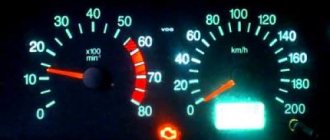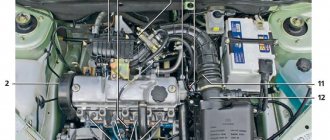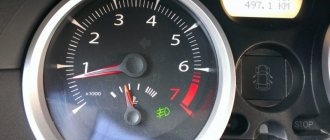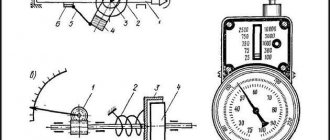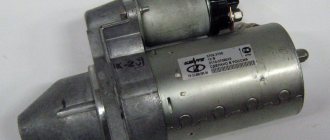A tachometer is a device that informs the driver about the engine speed. Based on the tachometer readings, the driver can choose the optimal operating mode of the internal combustion engine in various conditions.
The tachometer can also indicate certain malfunctions and malfunctions in the engine. More precisely, the tachometer needle can jump or float. If the tachometer needle jumps, this indicates the following problems:
- unstable crankshaft speed, malfunctions of the engine and its systems;
- problems with the tachometer itself, failure of the sensors or tachometer.
In this case, it is important that the engine and tachometer work normally, and the driver receives accurate information about engine speed. For this reason, it is necessary to determine why the tachometer needle is jumping or why the tachometer is not working. You also need to know how to find the cause of the problem. Read more in our article.
The device of a car tachometer
Several components are used to carry out measurements:
- A sensor that converts a measured quantity into an electrical signal.
- Block for processing and converting received information.
- Display device.
Analog
This type of tachometer is considered obsolete because it was used on older car models with carburetor engines. According to the principle of operation, an analog device resembles an ammeter, since it uses the deflection of a frame with current in a magnetic field.
The signal is sent from the ignition coil output and then converted into a sequence of identical pulses and sent to the integrating device. Because of this, the deviations of the arrows are comparable to the pulse frequency, i.e. crankshaft revolutions of the power plant.
Digital
Modern cars use digital tachometers that are controlled by an on-board computer. The data is synchronized with the crankshaft rotation sensor.
The operating principle is based on the Hall effect, or electromagnetic induction. The signal that is sent to the equipment depends on the speed of the crankshaft. The further circuit of the digital tachometer resembles a digital frequency meter.
The measurement results are displayed in various forms - from a dial indication, as in devices of the previous type, to digital icons on the instrument panel screen. In the second case, you can get any pictogram or picture.
Tachometer on a car: types and features
In the process of searching for possible reasons why the tachometer jumps, it is also necessary to separately take into account the design features of this device. Tachometers are:
- analog;
- digital.
Analog tachometers have an induction magnetic coil, and the speed is indicated by the tachometer needle, which moves along the scale. A digital tachometer displays information on an LCD display. The number of revolutions is transmitted due to the operation of a magnetic sensor, which records the passage of a certain point by the crankshaft.
By the way, another type of sensor can be an electronic sensor (optocoupler). Such a sensor generates a light beam and determines the rotation frequency by the reflection of the beam from certain areas.
In terms of accuracy, a digital tachometer is more accurate than an analogue solution. At the same time, analog tachometers are more common on cars and are installed as standard. The reason is that the device is simple and reliable. However, in this case, the driver receives only approximate information (with the caveat that maximum accuracy of crankshaft speed readings is not so important).
Digital tachometers are actively used for fine-tuning the engine and electronic ignition. They are standardly installed on sports cars or on cars with a digital instrument panel, and are also separately integrated into the cabin as a remote device. The presence of such a tachometer allows you to obtain accurate readings of revolutions and change gears at a strictly defined number of crankshaft revolutions.
Additionally, remote or standard digital tachometers have an indicator so that the driver knows exactly when the engine has spun up to a certain speed in a particular gear.
Analog tachometer device
One way or another, an analog tachometer remains the most common solution. Structurally, this solution consists of the following elements:
- pointer arrow;
- graduated scale;
- electromagnetic coil with shielded winding;
- wiring for transmitting data from the crankshaft sensor to the tachometer;
Simply put, the signal from the crankshaft is sent through wires to an electronic circuit, causing the needle to move along the scale. Readings can be taken from the shaft, from the generator or from the power take-off shafts. Additionally, the signal is converted taking into account a certain coefficient.
Why does the tachometer needle jump?
Like any other measuring instrument, the tachometer has extreme positions of the scale. They correspond to the set signal level. If you find that the tachometer needle is twitching, there may be a chaotic change in voltage in the circuit due to interference, or there may be a failure of individual components. Problems must be immediately localized and eliminated, because quite often they affect not only the measuring device, but also more important components.
Single deviations of the tachometer needle from 0 to the maximum value are allowed when starting the car. This is done to superficially check the serviceability of the indicators on the instrument panel.
There are several explanations why the tachometer needle twitches at idle or while the car is moving.
Malfunctions of the tachometer itself
The following problems occur with the tachometer:
- Problems with the wiring, loss of contact or signal from the sensor on the power unit. To perform diagnostics, you need to “ring” the wires using a multimeter. In addition, the contacts should be checked for oxidation and cleaned.
- Nutrition problems. At this stage, the voltage is checked at the “+” and “-” terminals. As an additional action, the "ground" is checked.
- Sensor malfunction. If the needle floats or cannot drop to the zero level, the measuring element itself may have failed. Therefore, you will need to check the sensor and replace it if damaged.
- Damage to the display or microcircuit. The problem occurs in cars with a digital tachometer. In most cases, the display cannot be repaired and must be replaced with a new one.
- Breaks in the ignition circuit. In case of such malfunctions, a full diagnosis of the system is carried out to eliminate possible failures.
- Incorrect setting. Often the tachometer begins to malfunction after a major repair or replacement of the dashboard. In this case, it needs to be adjusted and the arrow set to the zero position.
- Switch failure. The malfunction is accompanied by needle deviations at high speeds (from 4 thousand rpm). The switch cannot be repaired, so it is replaced with a new one.
Problems with the engine and its systems
If there are no problems with the measuring device and wiring, but the needle still jumps or displays the speed incorrectly, you should check the serviceability of the engine and related systems.
This often happens when there are problems with the ignition system. Even simple malfunctions of high-voltage wires (wear, oxidation, damage) or failure of spark plugs jeopardize the stability of the power plant.
You should also check the ECU to make sure it is creating the correct air/fuel mixture.
To determine the cause of malfunctions, a comprehensive engine diagnostics is carried out in a car repair shop. Experts check the ignition circuit, battery, sensors and wires. After eliminating the existing faults, the tachometer will work as before.
What's the result?
The analog tachometer needle jumps due to a malfunction of the device itself, unstable crankshaft speed of the internal combustion engine. To eliminate the possibility of device failure, a known working tachometer is installed on the car. Unstable speed of the crankshaft of the power plant occurs as a result of disturbances in the internal combustion engine systems. To identify breakdowns, a number of diagnostic measures will be required. Some components are diagnosed at a service station.
Has the tachometer needle jumped on your car? What caused the device to not work correctly? Write in the comments. Share the article on social networks and save it in bookmarks so that you can immediately find the information you need when necessary.
The tachometer jumps or the tachometer needle twitches - you can find out how to fix it from the video:
Video “Troubleshooting tachometer problems”
This video tells you what needs to be done to prevent the meter needle from twitching (the author of the video is T-Strannik).
The tachometer is not one of the “vital” devices of the “seven”, but its malfunction causes certain inconvenience. In addition, the situation when the VAZ 2107 tachometer jumps is a sign of problems in the ignition system or fuel supply to the engine. Therefore, at the first sign of a malfunctioning tachometer, you need to understand the causes of the breakdown and eliminate them immediately.
The connection diagram for the tachometer on a VAZ 2107 with a carburetor engine is slightly different from that used on models with an injector. But in general, the causes of the malfunction and the methods for eliminating them are similar.
Throttle valve malfunctions
Most modern injection power systems do not have IAC. Its role is played by the electric throttle valve. Using an electric motor, the ECU opens the throttle valve to the required angle, regulating the amount of air consumed by the engine at idle. Unlike the governor, which has no feedback, the ECU monitors the throttle position using 2 position sensors at once.
The symptoms of a faulty throttle valve are similar to the symptoms of a broken/contaminated IAC. Most often, eliminating speed surges and floating speed at idle is limited to flushing the throttle valve. To do this, you need to remove the throttle assembly and wash it well with gasoline and a soft lint brush.
It is strictly forbidden to clean the inside of the throttle with metal brushes or sharp objects. It is best to use special carburetor cleaners in aerosol cans for flushing.
If cleaning does not solve the problem of floating idle speed, start with computer diagnostics. It is likely that reading trouble codes and identifying anomalies in the position sensors will point you in the right direction to find the cause of unstable idle speed. Often, after flushing, the throttle, like the IAC, needs to be adapted using diagnostic equipment.
Video: Is the idle speed floating? Useful tips
Ignition system
As mentioned earlier, the ignition system of the VAZ 2107 car and the tachometer needle are interconnected; they cannot exist without each other
And if the arrow twitches, and all the above tips did not help, you should pay attention to the condition of the ignition elements. First of all, inspect the wires for damage or lack of contacts.
It is quite possible that there is a break inside the device itself. The photo shows a wiring diagram, study it to get an idea of where the wires go and where they come from. If the power system has a carburetor and a classic ignition system is installed, then it is possible that a breakdown of the capacitor installed in the lower part of the distributor has occurred.
In most cases, the needle jumps if there is a malfunction in the ignition system. It is quite possible that the Hall sensor is malfunctioning. But in this case, unstable engine operation will be felt. If you have an injector, then you should check the condition of the engine speed sensor and all connecting wires.
Is it possible to independently find the cause of floating speed?
As the experience of practicing diagnosticians shows, the speed begins to float after maintenance or other repair work in the engine compartment. Often, during the work process, craftsmen forget to connect or, unbeknownst to themselves, pull the vacuum hoses from the fittings. Therefore, if the car has recently been repaired, inspect the engine compartment for broken fittings and unconnected vacuum tubes. If a visual inspection turns up nothing, use a few simple methods to find air leaks.
- Using pliers, pinch the rubber hoses and pipes that fit into the manifold one by one. This way you turn off the system and eliminate its influence on engine operation.
- Spray water on the intake manifold and vacuum pipes. When water is sucked into the intake tract along with unaccounted air, you will hear a characteristic sound. Often the leak can be identified by hissing when the engine is idling.
- Build a smoke generator from available materials (there are a lot of instructions on the Internet for assembling such a device at home). The essence of the test is to fill the intake tract with smoke. In areas of leakage, smoke will escape. The test is best carried out in a room with the lights turned off, using a flashlight to highlight possible leak points. Before searching for the cause of floating speed, it is necessary to tightly plug the corrugation suitable for the air filter.
Hall Sensor
The tachometer on the VAZ 2107 (injector) reads information about engine speed from the computer. The latter, in turn, receives data from the Hall sensor. Poor contact at the sensor terminals or its malfunction leads to interruptions in engine operation and fluctuations in the tachometer needle. If the contacts can be cleaned, the sensor itself cannot be repaired. It is designed in such a way that the possibility of its repair is excluded. The faulty sensor must be replaced with a new one.
Fuel system malfunction
The cause of interruptions in engine operation and jumps in the tachometer needle can be either low-quality fuel or problems in the injection system. On carburetor models, disassemble the carburetor and clean the jets. Most often, a “jumping” tachometer is the result of a clogged idle jet. The VAZ 2107 tachometer (injector) can “jump” if there are problems in the injection system. In this case, it is necessary to flush the injectors. To check and clean the injection system, you need a special stand and equipment. It is better to entrust such work to service station specialists.
Malfunction of the gas distribution mechanism
When the tachometer needle begins to “jump” at high speeds, the problem may be associated with a malfunctioning gas distribution mechanism. In this case, it is necessary to check the tension of the timing belt connecting the crankshaft to the camshaft. In addition, the speed may “float” due to a malfunction of the engine itself. Here it is worth checking the compression in the cylinders or contacting an auto mechanic. If you delay diagnosis and repair, serious damage to the piston system may occur, which will require expensive complex repairs.
